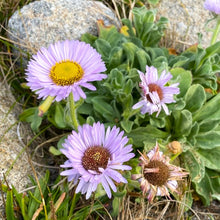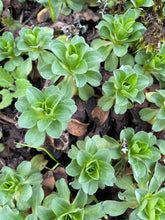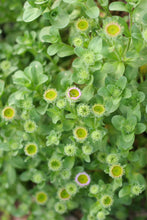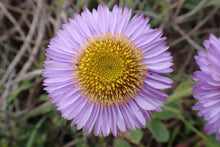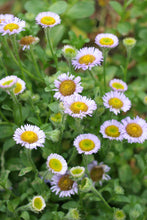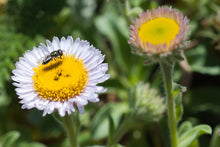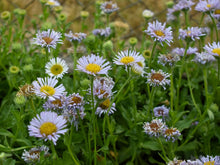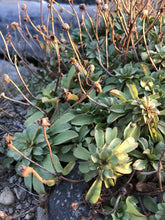
Erigeron glaucus
Beach daisy, also known as Seaside daisy, is a highly ornamental, low-growing perennial that can perform wonders in sunny areas of your garden. Tuck it into crevices between rocks and pavers, allow it to sprawl plentifully as a lush groundcover in perennial beds, or plant it as a border that cascades over rocks, logs and retaining walls - no matter the place it’s profuse lavender and yellow flowers will create bursts of lasting color, while supporting pollinators, all summer long.
- Plant type/canopy layer: perennial, deciduous, herbaceous plant
- Size at maturity: 6”-12” tall, 12”24” wide
- Light requirements: full sun to light shade
- Moisture requirements: dry to moist soil, well-drained
- Bloom time: May - Aug
- Growth rate/ease: fast growing, easy to grow
- Wildlife support: flowers are a nectar source for adult butterflies, bees and other insect pollinators; overall plant attracts and supports beneficial and pest eating insects and is a caterpillar host plant and larval food source for native butterflies and moths
- Native habitat/range: common on bluffs and sandy beaches along the Pacific Coast from northern California through Oregon. Portland Plant List - no.
- Special features & uses: evergreen; deer resistant; drought resistant; pollinator favorite; landscape uses include meadowscapes, pollinator gardens and rock gardens
Gardening with Beach Daisy: This tremendously attractive plant performs well in most sunny locations; from beds, to borders, to containers. Once established, it’s drought tolerant, only needing water infrequently (i.e. 1 - 2 times per month) during the summer drought. Snip spent flowers throughout the season for the longest bloom times and cut back aggressively every couple years to promote vibrant new growth and abundant blooms.
Photo Credit 1 (flowering habit): © Matt Berger, some rights reserved (CC-BY)
Photo Credit 2 (foliage): © Cricket Raspet, some rights reserved (CC-BY)
Photo Credits 3 & 5 (buds/flowers in the garden): Karli Del Biondo, Beetles and Bees
Photo Credit 4 (flower closeup): © Madeleine Claire, some rights reserved (CC-BY)
Photo Credit 6 (with insect): © Paul Asman, some rights reserved (CC-BY)
Photo Credit 7 (late season, dying back): Nikkie West, Sparrowhawk Native Plants
Photo Credit 8 (flowers done): © Andrew Conboy, some rights reserved (CC-BY)








